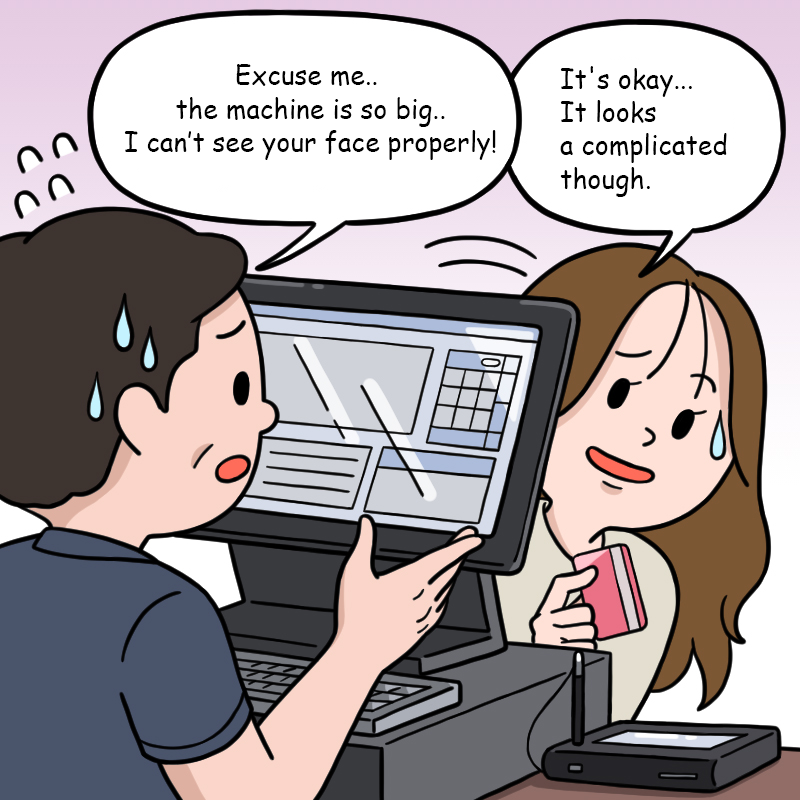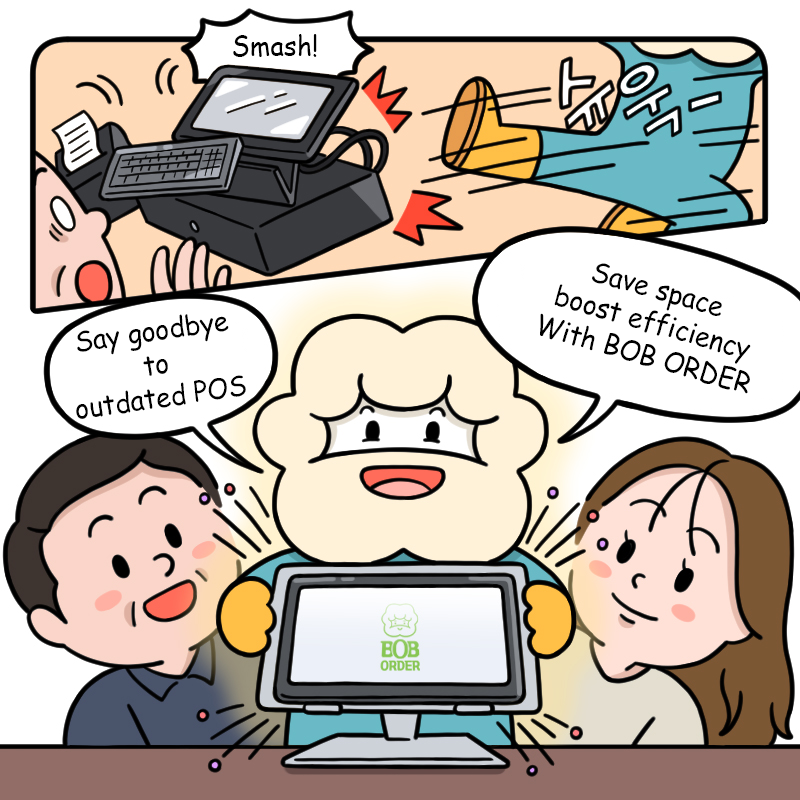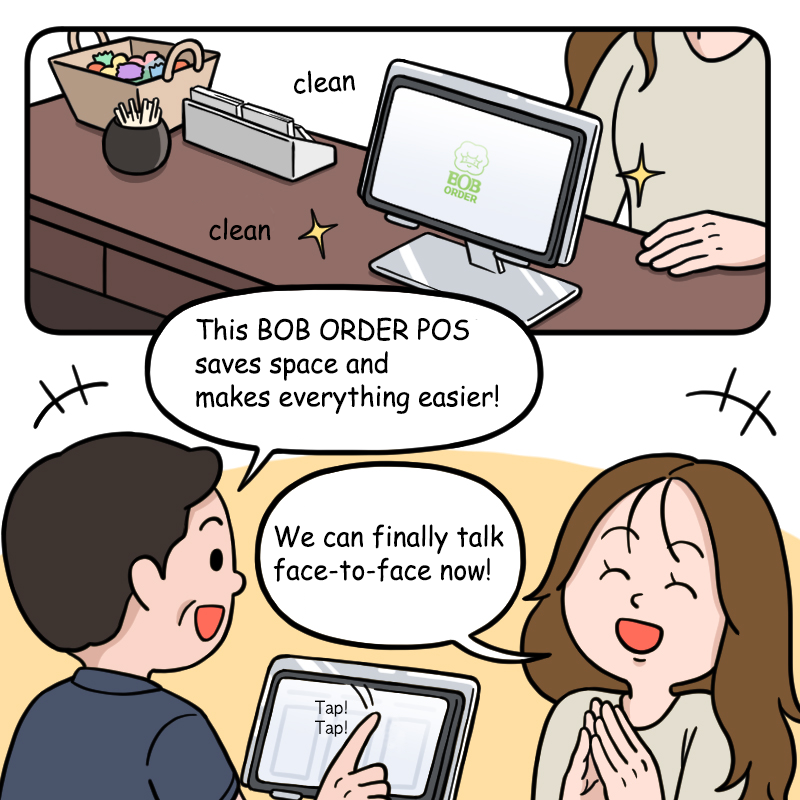Space Optimization
A store's POS system is one of the core operational tools. However, traditional POS systems are large and often take up a significant amount of space on the counter desk. These bulky POS systems cause the following problems:
1. Wasted Space and Cluttered Environment

When large POS equipment occupies most of the counter, the store's interior can appear cramped and cluttered. The counter space, which is used by both customers and staff, should be kept as clean as possible. However, the space taken up by bulky POS systems can interfere with this objective. Especially during busy meal times, even a small item can become a significant factor.
2. Difficulty Communicating with Customers
Large POS systems can act as a physical barrier between staff and customers. When a customer's face is obscured, effective communication becomes challenging, which can impact the quality of service. It becomes difficult to read customers' expressions, and customers may feel frustrated when interacting with staff. The larger the POS system, the greater these inconveniences become.

To address these inconveniences, more and more stores are adopting Tablet POS systems.
To Address These Inconveniences, Consider Efficiency, Customer Satisfaction, Space Optimization, and Operating Costs
1. Improved Efficiency of Mobile POS Systems
Numerous studies have demonstrated that mobile POS systems enhance operational efficiency compared to traditional POS systems. For example, the study by Michael et al. (2018) mentions that stores implementing mobile POS systems were able to significantly improve their work speed and efficiency. Employees can process payments directly near the tables, which increases turnover rates and reduces customer wait times since customers do not need to stand in line.
2. Enhanced Customer Satisfaction
Berman and Evans (2017) emphasize in their study focused on customer satisfaction that mobile POS plays a crucial role in enhancing the customer experience. Specifically, in restaurants, reducing the physical barriers between customers and staff allows for more personal and intimate service. According to the study, enabling customers to make payments directly at the table increased satisfaction with service quality by over 20%. This direct interaction with customers strengthens positive perceptions of the service and increases the likelihood of repeat visits.
3. Space Optimization and Store Environment
The study by Patterson et al. (2019) discusses the relationship between the size of POS systems and the store environment. This research concluded that traditional large POS systems create a cluttered and congested store environment, which is particularly inconvenient in smaller spaces. In contrast, mobile POS systems save space, providing a more spacious and comfortable environment. The study found that such space optimization can improve the overall image of the store, ultimately contributing to increased customer dwell time and enhancing factors related to customer satisfaction.
4. Reduction of Operating Costs
There are also studies that address the economic benefits of tablet-based POS systems. James & Clark (2020) evaluated that mobile POS systems reduce maintenance costs and have lower initial installation costs compared to traditional POS systems. Tablet POS systems allow for quick and easy software updates, enabling the rapid addition of the latest features. This is highly economical compared to the physical upgrades required by traditional POS systems.
5. Flexibility and Scalability of POS Systems
Lastly, the study by Yuan et al. (2021) explores the flexibility and scalability of mobile POS systems. Tablet-based POS systems offer the advantage of adding various functions through apps, allowing multiple functionalities such as customer management, reservation management, and sales analysis to be handled on a single device. This scalability helps reduce the complexity of store operations and serves as a powerful tool for real-time data analysis and customer management.
Conclusion

References
- Michael, R., Johnson, L., & Liao, H. (2018). The Impact of Mobile Point of Sale Systems on Operational Efficiency in Retail and Hospitality Industries. Journal of Technology in Business, 12(3), 45-52.
- Berman, B., & Evans, J. R. (2017). Retail Management: A Strategic Approach. Pearson Education. In this book, the authors discuss how technological advances, including mobile POS, enhance customer satisfaction and improve service quality.
- Patterson, C., Nguyen, T., & Smith, J. (2019). Optimizing Retail Space: The Role of Mobile POS Systems in Creating a Clutter-Free Environment. Journal of Retail Design, 5(2), 72-80.
- James, P., & Clark, M. (2020). Cost-Benefit Analysis of Traditional vs. Mobile POS Systems in Small Businesses. International Journal of Business and Economics, 15(1), 34-41.
- Yuan, F., Choi, S., & Lee, H. (2021). Expanding Functionality in Retail through Mobile POS Systems: A Case Study Approach. Journal of Information Technology and Retail Management, 9(4), 98-106.